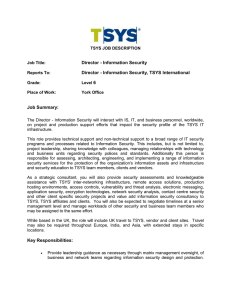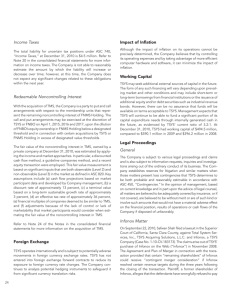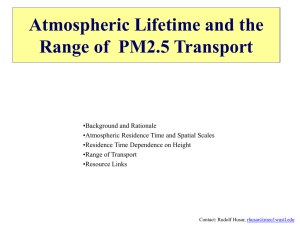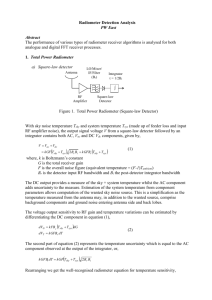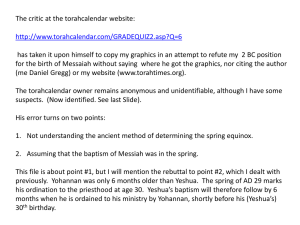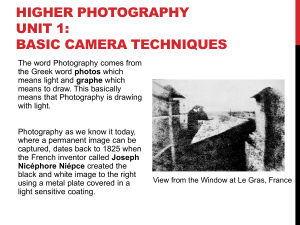AtmosphereWeatherForRadioAstronomy
advertisement
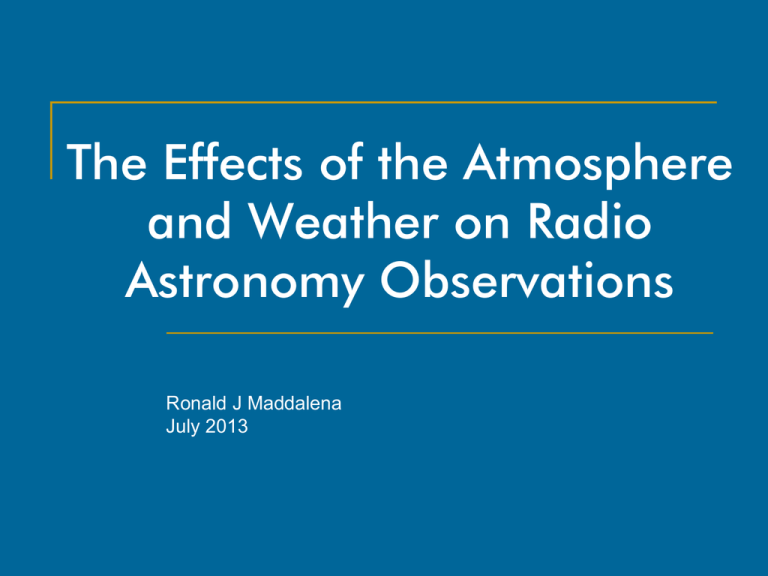
The Effects of the Atmosphere and Weather on Radio Astronomy Observations Ronald J Maddalena July 2013 The Influence of the Atmosphere and Weather at cm- and mm-wavelengths Opacity Calibration System performance – Tsys Observing techniques Hardware design Pointing Air Mass Calibration Interferometer & VLB phase errors Aperture phase errors Continuum performance Calibration Winds Refraction Cloud Cover Pointing Safety Telescope Scheduling Proportion of proposals that should be accepted Telescope productivity Structure of the Lower Atmosphere Refraction Refraction Index of Refraction is weather dependent: (n0 1) 106 77.6 PTotal (m Bar) T (C ) 273.15 3.73105 PH 2O (m Bar) T (C ) 273.15 2 ... PH 2O (m Bar) 6.112 e a 7.62 TDewPt (C ) where a 243.12 TDewPt (C ) Froome & Essen, 1969 http://cires.colorado.edu/~voemel/vp.html Guide to Meteorological Instruments and Methods of Observation (CIMO Guide) (WMO, 2008) Refraction For plane-parallel approximation: n0 • Cos(ElevObs)=Cos(ElevTrue) R = ElevObs – ElevTrue = (n0-1) • Cot(ElevObs) Good to above 30° only For spherical Earth: ElevObs ElevTrue a n0 cos( ElevObs ) 1 n0 dn(h) n(h) (a h) 2 n(h) 2 a 2 n02 cos2 ( ElevObs ) a = Earth radius; h = distance above sea level of atmospheric layer, n(h) = index of refraction at height h; n0 = ground-level index of refraction See, for example, Smart, “Spherical Astronomy” Refraction Important for good pointing when combining: large aperture telescopes at high frequencies at low elevations (i.e., the GBT) Every observatory handles refraction differently. Offset pointing helps eliminates refraction errors Since n(h) isn’t usually known, most (all?) observatories use some simplifying model. Example: ElevObs ElevTrue 4.70 n0 1 Cot ElevObs 2.24+ ElevObs Updated from: Maddalena, GBT memo 112, 1994. Relative Air Mass Relative Air Mass Ratio of column density along line of sight to column density toward zenith AirMass( ElevObs ) 1 (h) dh 0 (h) dh 2 a n0 2 1 cos ( ElevObs ) a h n ( h) 0 Rohlfs & Wilson, “Tools of Radio Astronomy” Relative Air Mass Not significantly weather dependent csc(ElevObs) breaks down when Elev < 15° Use instead: AirMass 0.02344 1.0140 5.18 sin ElevObs Elev 3 . 35 Obs csc(ElevObs ) for ElevObs 32 for ElevObs 32 Maddalena & Johnson, 2006 Atmospheric Opacity (τ) Hits observations twice: Attenuates the source Adds to received power (Tsys) TA TR* e AirMass Tsys TRcvr f SpilloverTGround 1 f Spillover TCMB e AirMass TR* e AirMass TAtm 1 e AirMass Signal-to-noise TA/Tsys Important for calibration: Some simplifications: Optically Thick (τ >> 1): Last term in Tsys becomes TAtm Optically Thin (τ << 1): Last term becomes TAtm • τ • AirMass Sometimes written as: AirMass TR* AirMass AirMass TR* Tsys TRcvr TCMB e TAtm 1 e AirMass TRcvr TCMB TAtm AirMass Radiative Transfer Through any Atmosphere Tippings to Determine τ Tsys TRcvr f SpilloverTGround 1 f Spillover TCMB e AirMass TAtm 1 e AirMass Tsys TRcvr TCMB TAtm 1 e AirMass TRcvr TCMB TAtm AirMass Requires knowing TAtm and fSpillover and good calibration Tcal/Tcal = TSysl/TSys = τ/τ Definition of TAtm TAtm (h) T (h) dh (h) T (h) dh (h) dh T hus, theslopein T ippingCurve TAtm (h) T (h) dh The slope in a tipping curve really isn’t related to the opacity!! Try instead: ; Calculates an estimate to Tatm from ground air temperature and frequencies. ; Only appropriate for freqs < 50 GHz. The rms uncertainty in my model is 3.5 K ; Maddalena & Johnson (2005, BAAS, Vol. 37, p.1438). ; ; freqs : list of frequencies in MHz ; TempK : ground temperature in K ; function quickTatm, freqs, TempK f = freqs/1000. A = 259.691860 - 1.66599001*f + 0.226962192*f^2 - 0.0100909636*f^3 + 0.00018402955*f^4 - 0.00000119516*f^5 B = 0.42557717 + 0.03393248*f + 0.000257983*f^2 - 0.0000653903*f^3 + 0.00000157104*f^4 - 0.00000001182*f^5 return, A + B*(TempK-273.15) end Quick, Simple, and Accurate τ Tsys TRcvr TCMB TAtm AirMass Quick, Simple, and Accurate τ Invert Tsys equation to solve for attenuation e AirMass 1 f T 1 f Atm Tsys TRcvr f SpilloverTGround Spillover T * T T Atm CMB R TAtm Tsys TRcvr TAtm TCMB At low frequencies and low Air Mass: Spillover Tsys TRcvr TCMB TAtm AirMass Every single observation tells you its opacity !! Just need to use your ensemble of observations to determine TRcvr Exercise 2: τ, Tsys , TAtm and Attenuation for Observation at the Zenith with No Spillover for a 10K Source H(km) H (km) κ(Nepers/km) TLayer(K) τ ∑τ Attenuation TA (K) Tsys (K) -------------------------------------------------------------------------------------------------------------------------------------------Above Atmosphere 0 0 0 1.0 10 12.7 34.8 12.00 1.0189e-07 222.34 17.3 17.55 1.6119e-05 203.99 11.7 5.557 1.0405e-04 225.49 8.5 3.260 4.0313e-04 250.79 6.0 2.465 5.4708e-04 265.69 4.2 1.778 8.9588e-04 275.99 2.9 1.308 1.8908e-03 282.59 2.0 0.956 4.0906e-03 287.89 1.4 0.565 8.2437e-03 287.79 1.1 0.315 0.0121247 288.69 0.8 0.251 0.0169950 288.59 -------------------------------------------------------------------------------------------------------------------------------------------TAtm = (Tsys - TA - TCMB • exp(- ∑τ)) / (1 - exp(- ∑τ)) = ____________ Total Tsys = Tsys + Trcvr = ____________ Formulae: τ = κ • H Attenuation = exp(-τ ) TA = TAPrevious • Attenuation Tsys = TsysPrevious • Attenuation + TLayer • (1 - Attenuation) Use: Trcvr = 15 K, TCMB = 2.7 K Opacity vs Frequency gfs3_c27_1190268000.buf Total Opacity Opacities from Various Atmosphere Components Water Continuum Dry Air Continuum Opacities from Various Atmosphere Components Water Line Oxygen Line Opacities from Various Atmosphere Components Rain Hydrosols Precipitable Water Vapor (PWV) vs Opacity Precipitable Water Vapor in mm Graphs suggest that τ ~ A + B • PWV(mm) Where A and B are frequency dependent. See Marvil (2010) EVLA Memo 143 for values of A and B for 1-50 GHz But, estimates can be in error if there are hydrosols or rain present. Precipitable Water Vapor from GroundLevel Conditions PWVH2O (mm) ~ Scale Height (km) • 216.7(mBar) • PH20 / TGround (K) Where Scale Height ~ 2.2 km Butler (1998), “MMA Memo 237” But, it’s a very rough value only and more useful for site statistics and not really suitable for calibration Affects of Winds Force = Air Density • Wind Speed2 Hooke’s Law: Force Displacement Telescope Beams are Gaussian G a 2 Frequency2 bVelocity4 Frequency2 e e G0 t Best t Needed 2 Tracking G 2 bVelocity4 Frequency2 e G0 For small : Tracking 1 b Velocity4 Frequency2 2 Condon & Balser (2011), DSS memo 5 Weather Forecasting for Radio Astronomy The standard products of the National Weather Service (other than winds, cloud cover, precipitation, and somewhat PWV) do not serve radio astronomy directly. But, the NWS products be reprocessed to generate forecast values that are more useful for radio astronomy. Vertical profiles Atmospheric pressure, temperature, and humidity as a function of height above a site (and much more). Derived from Geostationary Operational Environmental Satellite (GOES) soundings and, now less often, balloon soundings Generated by the National Weather Service, an agency of the NOAA. Bufkit, a great vertical profile viewer http://www.wbuf.noaa.gov/bufkit/bufkit.html Vertical Profiles 65 layers from ground level to 30 km Stratospheric (Tropapause ~10 km) Layers finely spaced (~40 m) at the lower heights, wider spacing in the stratosphere Available for major towns (Elkins, Hot Springs, Lewisburg) Three flavors of forecasts: 1 hr and 12 km resolution, 12 hr range, 1 hr updates 1 hr and 12 km resolution, 84 hr range, 6 hr updates 3 hr and 35 km resolution, 120 hr range, 12 hr updates Bufkit files available for “Standard Stations” Basics of Atmospheric Modeling Liebe, 1985, “Radio Science”, Vol 20, p. 1069. Maddalena (http://www.gb.nrao.edu/~rmaddale/Weather) The Accuracy of Radio-Astronomy Forecasts is High 22 GHz 41-45 GHz The Reliability of Radio-Astronomy Forecasts is High Correlation Between Forecasts Hr R rms (mm) ----------------------------------------------------6 0.985 1.76 12 0.978 2.11 18 0.972 2.41 24 0.968 2.58 30 0.960 2.91 36 0.952 3.15 42 0.942 3.46 48 0.932 3.73 54 0.922 4.03 60 0.910 4.35 66 0.898 4.64 72 0.885 4.95 78 0.875 5.19 User Software: cleo forecasts Web Page Summaries http://www.gb.nrao.edu/~rmaddale/Weather 3.5 and 7 day forecasts. Provides: Ground weather conditions Opacity and TAtm as a function of time and frequency Tsys and RESTs as functions of time, frequency, and elevation Refraction, differential refraction, comparison to other refraction models Weather.com forecasts NWS alerts Short summary of the modeling and list of references Overview (Pizza) Plots Overview (Pizza) Plots and GBT Scheduling GBT Dynamic Scheduling Uses cm- and mm-wave weather forecasts to determine the optimum way to schedule projects for the next 2 days Additional factors: Project ranking Availability of hardware Observer blackouts dates/times Allows for multiple observers on a project Proposal pressure vs frequency and LST range Observers are provided with emails when they are scheduled. If remotely observing, observers use VNC to conduct their experiment. Before one can remotely observe, one must first observe locally so that we can ensure remote observing will be fruitful. For more details, see: http://science.nrao.edu/gbt/scheduling/dynamic.shtml Condon & Balser (2011), DSS memo 4 Condon & Balser (2011), DSS memo 5 DSS Project Weather ‘Scoring’ Product of three measures of observing efficiency: Best AirMass T e SYS Forecasted Forecasted AirMass T e SYS Best Atmosphere 2 Best t 1 Needed t Surface : Loss in observing efficiency due to degradation of surface (<1 during the ‘day’, =1 at night) Tracking : Loss in observing efficiency due to winds (outlined above) plus servo system errors. The Influence of the Atmosphere and Weather at cm- and mm-wavelengths Opacity Calibration System performance – Tsys Observing techniques Hardware design Pointing Air Mass Calibration Interferometer & VLB phase errors Aperture phase errors Continuum performance Calibration Winds Refraction Cloud Cover Pointing Safety Telescope Scheduling Proportion of proposals that should be accepted Telescope productivity
